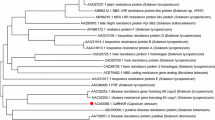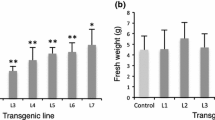Abstract
Several root-knot nematode (Meloidogyne spp.) resistance genes have been discovered in different pepper (Capsium annuum L.) lines; however, none of them has yet been cloned. In this study, a candidate root-knot nematode resistance gene (designated as CaMi) was isolated from the resistant pepper line PR 205 by degenerate PCR amplification combined with the RACE technique. Expression profiling analysis revealed that this gene was highly expressed in roots, leaves, and flowers and expressed at a lower level in stems and was not detectable in fruits. To verify the function of CaMi, a sense vector containing the genomic DNA spanning the full coding region of CaMi was constructed and transferred into root-knot nematode susceptible tomato plants. Sixteen transgenic plants carrying one to five copies of T-DNA inserts were generated from two nematode susceptible tomato cultivars. RT-PCR analysis revealed that the expression levels of CaMi gene varied in different transgenic plants. Nematode assays showed that the resistance to root-knot nematodes was significantly improved in some transgenic lines compared to untransformed susceptible plants, and that the resistance was inheritable. Ultrastructure analysis showed that nematodes led to the formation of galls or root knots in the susceptible lines while in the resistant transgenic plants, the CaMi gene triggered a hypersensitive response (HR) as well as many necrotic cells around nematodes.








Similar content being viewed by others
References
Aarts MG, Lintel B, Holub EB, Beynon JL, Stiekema WJ, Pereira A (1998) Identification of R-gene homologous DNA fragments genetically linked to disease resistance loci in Arabidopsis thaliana. Mol Plant Micro-Interact 11:251–258
Ammiraju JSS, Veremis JC, Huang X, Roberts PA, Laloshian I (2003) The heat-stable root-knot nematode resistance gene Mi-9 from Lycopersicon peruvianum is localized on the short arm of chromosome 6. Theor Appl Genet 106:478–484
Cai DG, Kleine M, Kifle S (1997) Positional cloning of a gene for nematode resistance in sugar beet. Science 275:832–834
Castaagnone-Sereno P, Bongiovanni M, Dalmasso A (1992) Differential expression of root-knot nematode resistance genes in tomato and pepper: evidence with Meloidogyne incongnita virulent and avirulent near-isogenic lineages. Ann Appl Biol 120:487–492
Chen RG, Zhang LY, Zhang JH, Zhang W, Wang X, Ouyang B, Li HX, Ye ZB (2006) Functional characterization of Mi, a root-knot nematode resistance gene from tomato (Lycopersicon esculentum L.). J Integrat Plant Biol 48(12):1458–1465
Collins NC, Webb CA, Seah S, Ellis JG, Hulbert SH, Pryor A (1998) The isolation and mapping of disease resistance gene analogs in maize. Mol Plant Micro-Interact 11:966–978
Dangl JL, Jones JDG (2001) Plant pathogens and integrated defense responses to infection. Nature 411:826–833
Deng Z, Huang S, Ling P, Chen C, Yu C, Weber CA, Moore GA, Gmitter FG Jr (2000) Cloning and characterization of NBS-LRR class resistance-gene candidate sequences in citrus. Theor Appl Genet 101:814–822
Di Vito M, Saccardo F (1979) Resistance of Capsicum species to Meloidogyne incognita. In: Lamberti F, Taylor EE (eds) Root-knot nematodes (Meloidogyne spp.): systematics, biology and control. Academic, London, pp 455–456
Di Vito M, Greco MN, Caella A (1985) Population densities of Meloidogyne incognita and yield of Capsicum annuum. J Nematol 17:45–49
Di Vito M, Saccardo F, Errico A, Zaccheo G, Catalano F (1992) Genetic of resistance to root-knot nematodes (Meloidogyne spp.) in Capsicum chacoense, C. chinense and C. frutescens. VIIIth Meeting ‘Genetics and Breeding on Capsicum and Eggplant’, Rome, Italy, 7–10 September 1992, pp 205–209
Djian-Caporalino C, Pijarowski L, Januel A, Lefebvre V, Phally T, Palloix A, Dalmasso A, Abad P (1999) A spectrum of resistance to root-knot nematodes (Meloidogyne spp.) in sweet pepper (Capsicum annuum L.) and inheritance of heat-stable resistance in the PM687 line derived from PI 322719. Theor Appl Genet 99:496–502
Ernst K, Amar K, Doris K (2002) The broad-spectrum potato cyst nematode resistance gene (Hero) from tomato is the only member of a large gene family of NBS-LRR genes with an unusual amino acid repeat in the LRR region. Plant J 31:127–136
Ferrier-Cana E, Geffroy V, Macadre C, Creusot F, Imbert-Bollore P, Sevignac M, Langin T (2003) Characterization of expressed NBS-LRR resistance gene candidates from common bean. Theor Appl Genet 106:251–261
Fery RL, Dukes PD (1984) Southern root-knot nematode of pepper: Studies on value of resistance (abstract). HortScience 19:211
Fery RL, Dukes PD (1996) The inheritance of resistance to the southern root-knot nematode in ‘Carolina Hot’ Cayenne pepper. J Am Soc Hort Sci 121:1024–1027
Fillatti JJ, Kiser J, Rose R, Comai L (1987) Efficient transfer of a glyphosate tolerance gene into tomato using a binary Agrobacterium tumefaciens vectors. Biotechnology 5:736–740
Flor HH (1971) Current status of the gene-for-gene concept. Annu Rev Phytopathol 9:13–21
Fulton TM, Chunwongse J, Tanksley SD (1995) Microprep protocol for extraction of DNA from tomato and other herbaceous plants. Plant Mol Biol Rep 13:207–209
Gilbert JC, McGuire DC (1956) Inheritance of resistance to severe root-knot from Meloidogyne incognita in commercial-type tomatoes. Proc Am Soc Hort Sci 68:437–442
Hare WW (1956) Resistance in pepper to Meoidogyne inncognita. Phytopathol 46:98–104
Hendy H, Pochard E, Dalmasso A (1983) Identification de 2 nouvelle sources de resistance aux nematodes du genre Meloidogyne chez le piment Capsicum annuum L. CR Séances Acad Agric Fr 69:817–822
Hendy H, Dalmasso A, Cardin C (1985) Difference in resistant Capsicum annuum attacked by different Meloidogyne species. Nematol 31:72–78
Hyde CL, Phillips GC (1996) Silver nitrate promotes shoot development and plant regeneration of chili pepper (Capsicum annuum L.) via organogenesis. In Vitro Cell Dev Biol Plant 32:72–80
Jones JDG (2001) Putting knowledge of plant disease resistance genes to work. Curr Opin Plant Biol 4:281–287
Keen NT (1990) Gene-for-gene complementarity in plant–pathogen interactions. Annu Rev Phytopathol 24:447–463
Lagudah ES, Moullet O, Appels R (1997) Map based cloning of a gene sequence encoding a nucleotide binding domain and leucine rich region at the Cre3 nematode resistance locus of wheat. Genome 40:659–665
Lambert KN, Tedford EC, Caswell EP, Williamson VM (1992) A system for continuous production of root-knot nematode juveniles in hydroponic culture. Phylopathol 82:512–515
Leister D, Ballvora A, Salamini F, Gebhardt C (1996) A PCR-based approach for isolating pathogen resistance genes from potato with potential for wide application in plants. Nat Genet 14:421–429
Leister D, Kurth J, Laurie DA, Yano M, Sasaki T, Devos K, Graner A, Schulze-Lefert P (1998) Rapid reorganization of resistance gene homologues in cereal genomes. Proc Natl Acad Sci USA 95:370–375
Lindsey DL, Clayshulte MS (1982) Influence of initial population densities of Meloidogyne incognita on three chili cultivars. J Nematol 14:35–41
Lopez CE, Zuluaga AP, Cooke R, Delseny M, Tohme J, Verdier V (2003) Isolation of resistance gene candidates (RGCs) and characterization of an RGC cluster in cassava. Mol Gen Genomics 269:658–671
Manoharan M, Vidya CS, Sita GL (1998) Agrobacterium mediated genetic transformation in hot chili (Capsicum annuum L. var. Pusa jwala). Plant Sci 131:77–83
Meyers BC, Dickerman AW, Michelmore RW, Sivaramakrishnan S, Sobral BW, Young ND (1999) Plant disease resistance genes encode members of an ancient and diverse protein family within the nucleotide-binding superfamily. Plant J 20:317–332
Milligan SB, Bodeau J, Yaghoobi J, Kaloshian I, Zabel P, Williamson VM (1998) The root-knot nematode resistance gene Mi from tomato is a member of the leucine zipper, nucleotide binding, leucine-rich repeat family of plant genes. Plant Cell 10:1307–19
Nombela G, Williamson VW, Muniz M (2003) The root-knot nematode resistance gene Mi-1.2 of tomato is responsible for resistance against the whitefly Bemisia tabaci. Mol Plant Micro-Interact 16:645–649
Ochoa-Alejo N, Ramirez-Malagon R (2001) In vitro chili pepper biotechnology. In Vitro Cell Dev Biol Plant 37:701–729
Omuega CO, Thomason IJ, Roberts PA (1988) A non-destructive technique for screening bean germ plasm for resistance to Meloidogyne incognita. Plant Dis 72:970–972
Penuela S, Danesh D, Young ND (2002) Targeted isolation, sequence analysis, and physical mapping of non TIR NBS-LRR genes in soybean. Theor Appl Genet 104:261–272
Rossi M, Goggin FL, Milligan SB, Kaloshian I, Ullman DE, Williamson VW (1998) The nematode resistance gene Mi of tomato confers resistance against the potato aphid. Proc Natl Acad Sci USA 95:9750–9754
Rossi M, Araujo PG, Paulet F, Garsmeur O, Dias VM, Chen H, Van Sluys MA, D’Hont A (2003) Genomic distribution and characterization of EST-derived resistance gene analogs (RGAs) in sugarcane. Mol Gen Genomics 269:406–419
Seah S, Yaghoobi J, Rossi M, Gleason CA, Williamson VM (2004) The nematode-resistance gene, Mi-1, is associated with an inverted chromosomal segment in susceptible compared to resistance tomato. Theor Appl Genet 108:1635–1642
Shen KA, Meyers BC, Islam-Faridi MN, Chin DB, Stelley DM, Michelmore RW (1998) Resistance gene candidates identified by PCR with degenerate oligonucleotide primers map to clusters of resistance genes in lettuce. Mol Plant Micro Interact 11:815–823
Tameling WIL, Elzinga SDJ, Darmin PS, Vossen JH, Takken FLW, Haring MA, Cornelissen BJC (2002) The tomato R gene products I-2 and Mi-1 are functional ATP binding proteins with ATPase activity. Plant Cell 14:2929–2939
Thies JA, Mueller JD, Fery RL (1997) Effectiveness of resistance to southern root-knot nematode in ‘Carolina Cayenne’ pepper (Capsicum annuum L.) in greenhouse, microplot, and field tests. J Am Soc Hort Sci 122:200–204
Thomas CM, Vos P, Zabeau M, Jones DA, Norcott KA, Chadwick BP, Jones JDG (1995) Identification of amplified restriction fragment polymorphism (AFLP) markers tightly linked to the tomato Cf-9 gene for resistance to Cladosporium fulvum. Plant J 8:785–794
van der Vossen EAG, van der Voort J, Kanyuka K (2000) Homologues of a single resistance-gene cluster in potato confer resistance to distinct pathogens: a virus and a nematode. Plant J 23:567–576
Watts VM (1947) The use of Lycopersicon peruvianum as a source nematode resistance in tomatoes. Proc Am Soc Hort Sci 49:233–234
Williamson VW, Gleason CA (2003) Plant–nematode interactions. Curr Opin Plant Biol 6:327–333
Williamson VW, Hussey RS (1996) Nematode pathogenesis and resistance in plants. Plant Cell 8:1735–1745
Wyss U, Grundler FMW, Munch A (1992) The parasitic behavior of second stage juveniles of Meloidigyne incognita in root of Arabidopsis thaliana. Nematologica 38:98–111
Yaghoobi J, Kaloshian I, Wen Y, Williamson VM (1995) Mapping a new nematode resistance locus in Lycopersicon peruvianum. Theor Appl Genet 91:457–464
Acknowledgments
The authors would like to thank Dr. Zhangjun Fei for critical review of this manuscript and Ms. Michelle Yu and Ms. Chitti Dharmanolla for proofreading. This research was supported by grant from the National Natural Science Foundation of P.R. China (30671416), Doctorate Program of University of Ministry of Education (200504028) and National Advanced Technology Research and Development Plan of China (AA212221).
Author information
Authors and Affiliations
Corresponding author
Additional information
Communicated by P. Lakshmanan.
Rugang Chen and Hanxia Li are contributed equally to this work.
Rights and permissions
About this article
Cite this article
Chen, R., Li, H., Zhang, L. et al. CaMi, a root-knot nematode resistance gene from hot pepper (Capsium annuum L.) confers nematode resistance in tomato. Plant Cell Rep 26, 895–905 (2007). https://doi.org/10.1007/s00299-007-0304-0
Received:
Revised:
Accepted:
Published:
Issue Date:
DOI: https://doi.org/10.1007/s00299-007-0304-0




